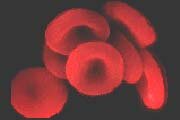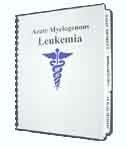 |
||
| HOME | ||
 |
||
| Acute Myelogenous Leukemia (AML) |
||
 |
||
| Other Leukemia Types (ALL / CLL / CML / HCL) |
||
 |
||
| Myelodysplastic Syndrome | ||
 |
||
| Symptoms and Diagnosis | ||
 |
||
| Leukemia Treatment Options | ||
 |
||
| " Chemotherapy | ||
 |
||
| " Blood Stem Cell Transplants | ||
 |
||
| " Radiation and Surgery | ||
 |
||
| " Chemo Side Effects | ||
 |
||
| " Clinical Trials Info | ||
 |
||
| " Coping with Leukemia | ||
 |
||
| " What to Ask Your Doctor | ||
 |
||
| Financial Assistance | ||
 |
||
| At Risk Jobs/Exposure | ||
 |
||
| Leukemia Resources | ||
 |
||
| Survivor's Story | ||
 |
||
| Leukemia News | ||
 |
||
|
Search for information:
|
||

|
Leukemia Cancer News - Return to Menu Study Finds New Designer Drug Is Potent Treatment For Chronic Myelogenous Leukemia BOSTON - 2005-03-07 - A laboratory study led by researchers at Dana-Farber Cancer Institute has shown that a potent and highly selective therapy for chronic myelogenous leukemia (CML) may ultimately be more effective than Gleevec®, the current standard of care. The researchers report in the February issue of Cancer Cell that the new compound, AMN107, is about 20 times more potent than Gleevec and is effective in treating Gleevec-resistant disease in model systems. Discovered by and in development with Novartis Pharma AG, AMN107 is a small molecule tyrosine kinase inhibitor. Related News Stories Experimental Drug Shown To Block Mutant Protein Causing Blood Disease (September 28, 2004) -- Scientists at Dana-Farber Cancer Institute and Brigham and Women's Hospital have prolonged the lives of mice with a rare blood disorder by using an experimental drug that blocks signals promoting ... > full story Promising New Therapies For Deadly Form Of Leukemia (June 12, 2002) -- Fresh from successes in the development of the cancer-fighting drug Gleevec, researchers are now setting their sights on a form of acute myelogenous leukemia (AML) that carries a bleak prognosis. ... > full story Rare Blood Disease Shown To Be A Form Of Treatable Cancer; Genetic Mechanism Of Disease Is Discovered (March 27, 2003) -- In the process of figuring out why an anti-cancer drug is effective in treating patients with a rare blood disorder known as hypereosinophilic syndrome, or HES, researchers at Brigham and Women's ... > full story "While Gleevec represents a major treatment advance for CML approximately 95 percent of patients treated with Gleevec achieve remission there clearly is a need for therapies that produce longer remissions, are active against advanced disease, and can be used when Gleevec loses effectiveness," says Dana-Farber's James Griffin, MD, senior author of the study. Gleevec shuts down CML by blocking the function of Bcr-Abl, the abnormal tyrosine kinase protein in the leukemic cells that causes them to grow too quickly. However, it does not bind very tightly to this protein, and patients can develop a resistant type of Bcr-Abl that no longer binds to Gleevec at all. Using rational drug design to circumvent these shortcomings, researchers at Novartis determined the crystal structure of Bcr-Abl, and then constructed compounds that would lock into the receptor more securely than Gleevec. Investigators at Dana-Farber tested the new compounds to measure their effectiveness against CML in laboratory cell cultures and mice with the disease. Data from the study published in Cancer Cell showed that in experiments with laboratory samples of CML cells, AMN107 killed the cells more effectively than Gleevec. In follow-up studies with mice with a human form of CML, AMN107 produced lengthier remissions than Gleevec and triggered remissions in animals in which the disease had become resistant to Gleevec. Side effects in the animals were minimal. Synthesized in August 2002, AMN107 entered early Phase I clinical studies in May 2004 21 months later. Data presented last December at the American Society of Hematology showed that AMN107 had demonstrated significant clinical activity in the most challenging setting: Gleevec resistant accelerated and blast crisis CML patients. "We're very encouraged by the results so far," remarks Griffin, who is also a professor of medicine at Harvard Medical School. "This is an elegant example of how rational drug design developing drugs based on a molecular understanding of cell structures and processes can be used to attack human diseases." The findings contribute to a larger Dana-Farber research effort, dubbed the "Kinase Project," which seeks to identify abnormal tyrosine kinases -- enzymes that spark or halt growth -- in cancer cells and test agents known to act against them. The Cancer Cell study's lead author is Ellen Weisberg, PhD, of Dana-Farber. Co-authors include researchers at Dana-Farber, Novartis, Brigham and Women's Hospital, and Children's Hospital Boston. ### The preclinical study was conducted as part of a research collaboration between Novartis Pharma AG and Dana-Farber. Promising New Therapies For Deadly Form Of Leukemia 2002-06-12 - Fresh from successes in the development of the cancer-fighting drug Gleevec, researchers are now setting their sights on a form of acute myelogenous leukemia (AML) that carries a bleak prognosis. They have identified two new drugs that inhibit a specific enzyme that drives development of the deadliest form of AML. It is hoped that the two drugs -- and others now in clinical trials -- will pack the same potent punch that has made Gleevec (STI571) so effective against chronic myelogenous leukemia. The scientists reported on studies of the new drugs, called PKC412 and CT53518, in two articles that will be published in the June 18, 2002, issue of the journal Cancer Cell. The articles received immediate early publication status and were published online May 31, 2002. Howard Hughes Medical Institute investigator D. Gary Gilliland at Harvard Medical School and Brigham and Women's Hospital is one of the senior authors of the articles. According to the American Cancer Society, AML accounts for about 90 percent of all adult leukemias, with about 10,600 new cases in the United States each year. The five-year, disease-free survival rate is about 14 percent, and there are about 7,400 deaths from AML each year in the United States, said Gilliland. AML is caused by a defect in bone marrow cells, which become "frozen" in an early stage of development. The immature cells cannot differentiate normally and they interfere with blood cell production, causing anemia, hemorrhaging and disruption of organ function. Most adults who develop AML will die from complications related to their disease or from complications of intensive chemotherapy. According to Gilliland, a deadly form of AML that occurs in about one-third of patients is caused by a mutation in an enzyme called the FLT3 receptor. This receptor is a type of protein called a receptor tyrosine kinase that is embedded in the membranes of developing blood cells. FLT3 normally switches on at specific times during the maturation of blood cells. In acute myelogenous leukemia, however, the gene for FLT3 is mutated, so that it produces a receptor that is constantly or constitutively active. This activity disrupts the blood cells' development and causes uncontrolled proliferation. The most common form of FLT3 gene mutation creates an "internal tandem duplication" (hence the designation FLT3-ITD) that creates an abnormal FLT3 receptor that promotes the growth and survival of cancerous cells. "The FLT3 receptor is a particularly good target for drugs because it is a constitutively active tyrosine kinase, as is the BCR/ABL enzyme that is involved in chronic myelogenous leukemia," said Gilliland. "The BCR/ABL enzyme can be selectively blocked by the small molecule inhibitor Gleevec. We have used similar strategies to design small molecule inhibitors of FLT3. These irreversibly fit critical parts of the enzyme -- like a key fits a lock -- and turn off the FLT3 kinase receptor." In initial screening studies, one of the Cancer Cell co-authors, James D. Griffin and colleagues at Dana-Farber Cancer Institute and Brigham and Women's Hospital tested a large number of kinase inhibitors that they obtained from Novartis Pharma AG in Switzerland. The researchers showed that the compound code-named PKC412 was a highly effective inhibitor of FLT3. "This was a particularly attractive agent because it had already been through clinical trials as an inhibitor of specific kinases in solid tumors," said Gilliland. "However, in Novartis' tests it had very modest activity, so they had not planned further development of the drug." After Griffin's team showed that PKC412 could inhibit FLT3, Gilliland and his colleagues tested the drug in a mouse model of acute myelogenous leukemia. The scientists introduced the FLT3-ITD enzyme into the bone marrow cells of mice that had received radiation treatment to deplete their immune systems. After allowing the AML to develop fully in the animals, the scientists tested PKC412's impact on AML. "When we gave these mice oral doses of PKC412, we found one hundred percent survival at the endpoint of the study, versus one hundred percent mortality in the animals that were treated with a placebo," said Gilliland. Analyses showed that PKC412 was a powerful inhibitor of the enzyme at doses that produced very little toxicity. Clinical trials of PKC412 are now underway at Harvard Medical School, and initial results should be available within months, Gilliland said. Gilliland and colleagues at Millennium Pharmaceuticals, Inc., Emory University, Dana-Farber and Brigham and Women's, also examined CT53518, a compound initially identified at Millennium as a potent FLT3-ITD inhibitor. Subsequent testing in human acute myelogenous leukemia cell lines confirmed its effectiveness. "We found CT53518 to be a potent inhibitor at about the same concentration as PKC412," said Gilliland. "It's very effective at killing leukemia cells in culture and in prolonging survival in our mouse model of AML." Some of the mice showed apparent resistance to the drug, said Gilliland. The cause of the drug resistance is currently under investigation, but may be similar to resistance to Gleevec observed in some patients with CML. CT53518 is also now in clinical trials at Harvard, and at four other sites around the country. Initial results should be available in about a year, said Gilliland. Although both drugs have shown high effectiveness, they show different specificities and properties that need to be explored in clinical trials. In addition to PKC412 and CT53518, there are other drugs in early stages of clinical testing that are showing considerable promise in treating acute myelogenous leukemia, said Gilliland. These include CEP-701, a drug developed by Cephalon in collaboration with researchers at The Johns Hopkins University School of Medicine, and SU11248, which under development by SUGEN and is currently in phase I clinical trials. "I think the wonderful thing about these four drugs is that they are all effective FLT3 inhibitors, yet they are very different chemically," said Gilliland. "Thus, if we encounter cases of acute myelogenous leukemia that are resistant to one drug, we have alternatives that give us the very best chance for circumventing that resistance." More broadly, said Gilliland, the discovery of drugs that are successful in treating one-third of acute myelogenous leukemia cases involving FLT3-ITD offers hope for the development of new drugs that target other forms of the leukemia. "The implication of these findings is that there must be other tyrosine kinases out there that we haven't discovered yet, whose mutant forms are constitutively active, and cause acute myelogenous leukemia," he said. Gilliland and his colleagues are now doing a genome-wide search for other tyrosine kinases that fit that profile.
|
|
|


